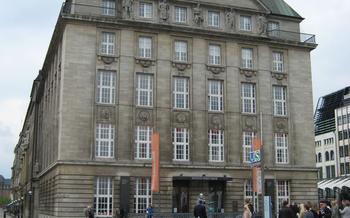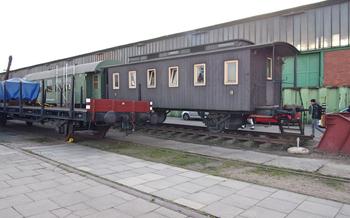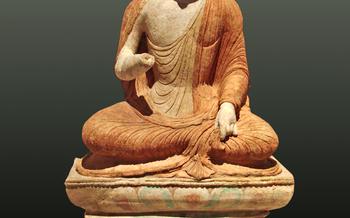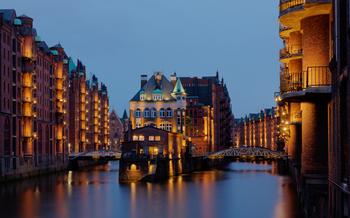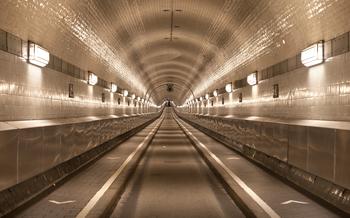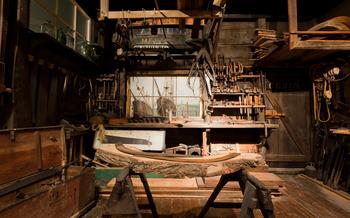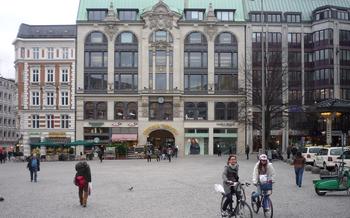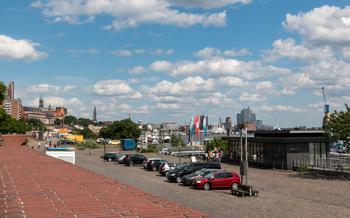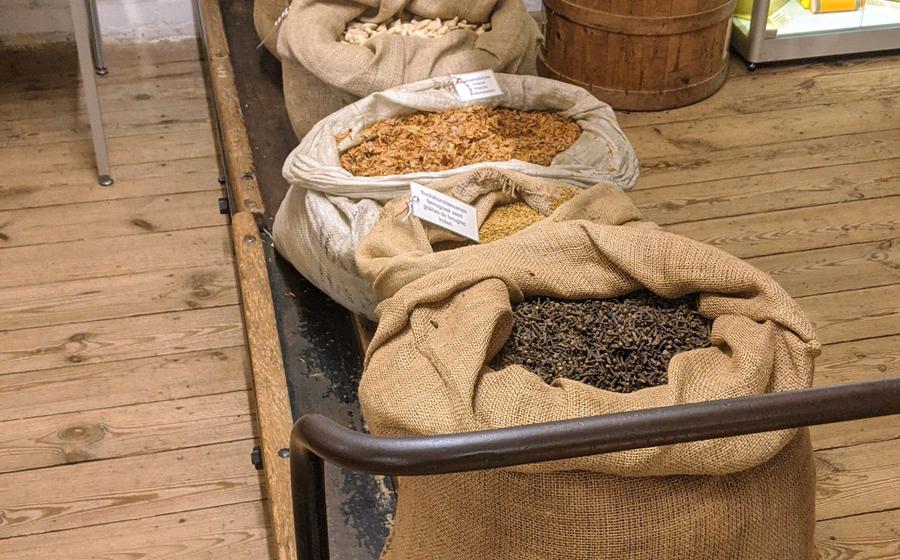
Spicy's Gewürzmuseum
- The Culinary Heart of Hamburg
- Spicy's Gewürzmuseum: A Sensory Adventure
- A Journey Through Time and Taste
- Exploring the Museum's Treasures
- Spices of the World:
- The Art of Spice Blending
- Culinary Workshops and Demonstrations
- Aromatic Garden and Rooftop Terrace
- Spice Shop and Tasting Bar
- Educational Programs for All Ages
- Temporary Exhibitions and Special Events
- Accessibility and Visitor Information
- Sustainability and Ethical Sourcing
- Sensory Overload and Lasting Impressions
- Insider Tip:
The Culinary Heart of Hamburg
Hamburg, a vibrant port city in northern Germany, has a rich history as a trading hub for spices. The city's strategic location on the Elbe River made it a gateway to the Orient, and its merchants played a crucial role in bringing exotic spices from far-off lands to Europe. The allure of the Speicherstadt district, a UNESCO World Heritage Site, lies in its grand brick warehouses that once stored vast quantities of spices, coffee, and tea. Amidst this historical backdrop, Hamburg proudly houses the world's largest spice museum, inviting visitors to embark on a sensory adventure that celebrates the diversity, history, and cultural significance of spices.
Spicy's Gewürzmuseum: A Sensory Adventure
Spicy's Gewürzmuseum is a true feast for the senses, inviting visitors to embark on a captivating journey through the world of spices. The museum's diverse collection boasts over 500 varieties of spices from every corner of the globe, each with its own unique story to tell. Interactive exhibits bring the history, cultivation, and uses of spices to life, allowing visitors to engage with these culinary treasures in a truly immersive way. From the pungent aroma of freshly ground peppercorns to the vibrant hues of exotic chili peppers, the museum offers a sensory overload that is both educational and exhilarating.
A Journey Through Time and Taste
Spicy's Gewürzmuseum offers a unique perspective on the historical significance of spices. Visitors are taken on a journey through time, exploring the impact of the spice trade on global exploration, cuisine, and cultural traditions. The museum's exhibits showcase ancient spice routes, highlighting Hamburg's role as a gateway to the Orient and a major hub for the spice trade.
Interactive displays bring to life the stories of intrepid explorers and merchants who ventured into uncharted territories in search of exotic spices. Visitors can learn about the challenges and triumphs of these early spice traders, as well as the profound impact their discoveries had on the culinary and cultural landscape of the world.
The museum also delves into the evolution of spice usage, tracing its journey from ancient medicine and religious rituals to its indispensable role in modern-day cooking. Visitors gain insights into the medicinal properties of spices, their use in traditional healing practices, and their symbolic significance in various cultures.
Exploring the Museum's Treasures
Spicy's Gewürzmuseum houses a vast and diverse collection of spices from around the world, showcasing their rich history, cultivation, and culinary significance. Visitors can embark on a journey through time and taste as they explore the museum's interactive exhibits.
The museum's displays feature rare and exotic spices, each with a unique story to tell. Visitors can touch, smell, and even taste different spices, immersing themselves in a sensory experience that brings the world's flavors to life. Interactive displays provide in-depth information about the cultivation, processing, and uses of various spices, highlighting their importance in global cuisine and trade.
Thematic sections of the museum showcase the culinary and medicinal properties of spices, demonstrating their versatility and cultural significance. From ancient spice routes to modern-day culinary trends, the museum offers a comprehensive exploration of the world of spices, making it a must-visit destination for food enthusiasts, historians, and anyone curious about the culinary arts.
Spices of the World:
Spices, like precious gems, originate from diverse corners of the globe, each with its own unique story to tell. The museum's exhibits take visitors on a journey across continents, exploring the diverse origins of these culinary treasures. From the tropical rainforests of Southeast Asia, where fragrant nutmeg and cloves thrive, to the sun-baked deserts of the Middle East, where cumin and coriander add warmth and depth to dishes, the museum showcases the remarkable diversity of spices.
The influence of climate, soil conditions, and cultivation practices on the flavor and quality of spices is also explored. Visitors learn how the rich volcanic soils of Madagascar produce vanilla beans with an unparalleled aroma, while the cool, misty air of the Himalayas nurtures the growth of aromatic cardamom. The museum's exhibits highlight the interconnectedness of spices with their environment, demonstrating how geography shapes their distinctive characteristics.
Insights into the unique characteristics and uses of spices from different regions are also provided. Visitors discover the versatility of paprika, a spice with roots in Central and South America, which adds vibrant color and smoky flavor to dishes worldwide. They learn about the delicate sweetness of Japanese sansho pepper, a citrusy spice that enhances the flavors of seafood and tempura. The museum's exhibits celebrate the culinary diversity of spices, inspiring visitors to experiment with new flavors and create exciting dishes that reflect the richness of global cuisine.
The Art of Spice Blending
The art of spice blending is an ancient tradition that has been passed down through generations. At Spicy's Gewürzmuseum, visitors can learn the secrets of creating harmonious spice blends that will elevate their cooking to new heights. Interactive displays and workshops introduce visitors to the different flavor profiles of spices and teach them how to combine them to create complex and delicious dishes.
One of the most important aspects of spice blending is understanding the balance between different flavors. Spicy, sweet, sour, salty, and bitter are the five basic tastes that spices can contribute to a dish. By carefully combining spices from each of these categories, cooks can create a harmonious blend that is both flavorful and nuanced.
Another important consideration when blending spices is the texture and aroma of each ingredient. Some spices, such as cumin and coriander, have a coarse texture that can add depth and interest to a dish. Others, such as paprika and turmeric, have a fine texture that can dissolve into a sauce or marinade. By combining spices with different textures, cooks can create a blend that is both visually appealing and flavorful.
Finally, it is important to consider the purpose of the spice blend. Are you using it to add flavor to a soup, a stew, or a marinade? Each type of dish requires a different balance of spices. For example, a spice blend for a soup should be more subtle than a blend for a grilled meat.
With a little practice, anyone can learn to blend spices like a pro. By experimenting with different combinations of spices, you can create your own unique blends that will add flavor and excitement to your cooking.
Culinary Workshops and Demonstrations
Spicy's Gewürzmuseum offers a range of culinary workshops and demonstrations that provide an immersive and hands-on experience for visitors. These workshops are led by experienced chefs and culinary experts who share their knowledge and passion for spices. Participants have the opportunity to learn about the art of spice blending, create their own spice mixes, and cook delicious dishes using a variety of spices.
One of the most popular workshops is the "Spice Blending Masterclass," where participants learn the basics of creating harmonious spice blends for cooking. They are introduced to different spices, their flavor profiles, and how to combine them to create unique and flavorful blends. Participants then get to create their own spice blends to take home and use in their own cooking.
For those who want to delve deeper into the world of spice-infused cuisine, the museum offers cooking demonstrations and classes that focus on specific cuisines or dishes. These classes cover a wide range of topics, from traditional Indian curries to Thai stir-fries and Mexican salsas. Participants learn about the history and cultural significance of the dishes, as well as the techniques and spices used to create them.
The workshops and demonstrations at Spicy's Gewürzmuseum are a great way to learn more about spices, expand your culinary skills, and create delicious and flavorful dishes at home. Whether you are a seasoned cook or just starting out, these experiences offer something for everyone who is passionate about food and spices.
Aromatic Garden and Rooftop Terrace
The Spicy's Gewürzmuseum offers a unique escape from the bustling city with its aromatic garden and rooftop terrace. Located on the top floor of the museum, the terrace provides breathtaking panoramic views of Hamburg's skyline, including the iconic Speicherstadt district and the Elbe River. Visitors can relax and unwind while enjoying the fragrance of fresh herbs and spices that fill the air.
The aromatic garden is a haven for plant enthusiasts and offers a closer look at the diverse varieties of herbs and spices grown in different parts of the world. Visitors can stroll through the garden, admire the vibrant colors and textures of the plants, and learn about their culinary and medicinal properties.
Whether you're seeking a moment of tranquility or simply want to enhance your appreciation for spices, the aromatic garden and rooftop terrace are must-visit destinations within the museum. Take a deep breath, savor the scents, and let the beauty of nature transport you to a world of culinary delights.
Spice Shop and Tasting Bar
The museum's spice shop is a treasure trove of aromatic delights, where visitors can purchase a wide range of spices, blends, and related products. From classic staples like cumin and coriander to exotic varieties like sumac and fenugreek, the shop offers a diverse selection to suit every palate.
Adjacent to the shop is a tasting bar, where visitors can embark on a culinary adventure and sample different spices before making a purchase. Knowledgeable staff members are on hand to guide visitors through the tasting experience, providing insights into the unique flavors and properties of each spice.
For those looking to enhance their cooking skills, the museum offers a variety of spice blends specially curated by expert chefs. These blends, meticulously crafted to complement specific cuisines and dishes, are a convenient way to add depth and complexity to home cooking.
Whether you're a seasoned cook or a novice in the kitchen, the Spicy's Gewürzmuseum's spice shop and tasting bar offer an immersive experience that will tantalize your taste buds and inspire your culinary creativity.
Educational Programs for All Ages
Spicy's Gewürzmuseum recognizes the importance of educating younger generations about the fascinating world of spices. To this end, the museum offers a range of educational programs tailored for school groups and families. These programs aim to introduce children to the diverse origins, history, and uses of spices, fostering an appreciation for their culinary, medicinal, and cultural significance.
Interactive activities and workshops form the core of these educational programs. Children engage in hands-on experiences, such as exploring the museum's collection of spices, participating in spice-blending workshops, and learning about the role of spices in global cuisine. Through these activities, they develop a deeper understanding of the spices that flavor their food and the integral role they play in our daily lives.
The museum's commitment to education extends beyond school groups. Families are encouraged to visit and immerse themselves in the world of spices together. Family-friendly activities, such as spice-themed scavenger hunts and interactive quizzes, make learning about spices a fun and engaging experience for all ages.
By providing these educational programs, Spicy's Gewürzmuseum plays a vital role in cultivating a new generation of spice enthusiasts. It instills in children a sense of curiosity and appreciation for the diverse flavors and aromas that spices bring to our world.
Temporary Exhibitions and Special Events
Spicy's Gewürzmuseum is not only home to a permanent collection of spices but also hosts temporary exhibitions that delve into specific themes related to spices and global cuisine. These exhibitions offer visitors an opportunity to explore the diverse culinary traditions and cultural significance of spices. Past exhibitions have showcased the history of spice cultivation in India, the role of spices in ancient medicine, and the influence of spices on the development of modern gastronomy.
In addition to temporary exhibitions, the museum also organizes special events throughout the year, such as themed dinners, spice-tasting sessions, and cultural performances. These events provide a unique and immersive experience, allowing visitors to engage with the museum's curators and experts to learn more about the fascinating world of spices. Special events are often held in collaboration with renowned chefs, food historians, and spice traders, ensuring that visitors have access to the latest insights and trends in the world of spices.
Accessibility and Visitor Information
Visiting the Spicy's Gewürzmuseum is a must for any food enthusiast or traveler interested in learning about the world of spices. The museum is open to the public from [Museum Opening Hours], and admission fees vary depending on the type of ticket and any special exhibitions or events. Visitors with disabilities are welcome, and the museum is wheelchair accessible with elevators and ramps throughout the building.
Guided tours are available in multiple languages and provide an in-depth look at the museum's collection and history. Audio guides are also available for self-guided tours, allowing visitors to explore the museum at their own pace and in their preferred language. To make the most of your visit, plan to spend at least two hours exploring the museum's exhibits and interactive displays.
The museum is conveniently located in the heart of Hamburg's historic Speicherstadt district, a UNESCO World Heritage Site. After your visit, take some time to wander through the cobblestone streets and canals of this vibrant neighborhood, admiring the beautiful architecture and enjoying the lively atmosphere. Numerous restaurants, cafés, and shops are within walking distance, offering a variety of dining and shopping options.
Sustainability and Ethical Sourcing
Spicy's Gewürzmuseum is committed to promoting sustainable and ethical practices in the spice trade. The museum works closely with local farmers and cooperatives around the world to ensure that spices are cultivated and harvested using sustainable methods and that farmers receive fair compensation for their work. The museum also educates visitors about the importance of ethical sourcing and encourages them to make informed choices when purchasing spices. Visitors can learn about the challenges facing spice farmers and the importance of supporting sustainable agriculture practices. By promoting ethical sourcing, the museum aims to create a more just and sustainable global spice trade that benefits both producers and consumers.
Sensory Overload and Lasting Impressions
A visit to Spicy's Gewürzmuseum is a sensory overload that will leave a lasting impression. The vibrant colors, heady aromas, and exotic flavors of spices from around the world create an unforgettable experience.
As you wander through the exhibits, you'll be amazed by the diversity of spices and their unique properties. From fiery chili peppers to fragrant cardamom pods, each spice tells a story of its origin, cultivation, and use. The interactive displays invite you to touch, smell, and taste different spices, engaging your senses and deepening your understanding of their culinary and medicinal properties.
The museum's collection is a testament to the cultural and economic importance of spices throughout history. Spices have shaped our culinary traditions, influenced global exploration, and played a vital role in trade and commerce. As you learn about the spice trade's impact on global cuisine and the ancient spice routes that connected continents, you'll gain a newfound appreciation for the spices that grace your kitchen shelves.
A visit to Spicy's Gewürzmuseum is not just an educational experience but also a sensory adventure that will inspire you to experiment with new flavors and aromas in your own cooking. The museum's collection and exhibits are a celebration of the diversity and richness of spices, reminding us of their ability to transform ordinary dishes into extraordinary culinary experiences.
Insider Tip:
For a truly unique experience, venture beyond the museum's walls and head to the nearby "Clouds Heaven's Bar & Kitchen" located on the 23rd floor of the Tanzturm building. While savoring delectable fusion cuisine infused with aromatic spices, you'll be mesmerized by the breathtaking panoramic views of Hamburg. Don't miss the opportunity to indulge in their signature cocktails, expertly crafted with a touch of spice that will leave your taste buds tingling. As a special treat, consider purchasing a set of rare spices from the museum's shop and trying your hand at recreating some of the exotic dishes you encountered during your visit.
